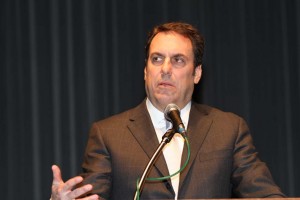In a sharp reversal of course, General Motors has agreed to reinstate 661 of the more than 2,000 dealers it had planned to eliminate after its bankruptcy, last year, though more than 400 other retailers may yet be reprieved through a Congressionally-mandated arbitration process.
The final GM dealer count is yet to be determined, company officials cautioned, during a conference call with reporters on Friday afternoon, but it will likely approach 5,000 by the time all is wrapped up. That’s significantly more than the 4,100 retailers the automaker had hoped to go forward with, but still far less than the 6,150 dealers that were representing General Motors in the U.S., as recently as December 2008.
“We are eager to restore relationships with our dealers, and get back to doing what we do best – selling cars and taking care of customers,” said Mark Reuss, President, GM North America.
When GM filed for Chapter 11, last year, the maker said it would streamline its retail network, in part reflecting the fact that it planned to eliminate four of eight brands during the bankruptcy process. The strategy also reflected conventional wisdom that since there’d be more sales per showroom dealers, in turn, would be willing to invest more in the surviving General Motors brands.
But the move kicked off a firestorm, especially with the automaker surviving only on the largesse of the federal Treasury. Eventually, Congress passed a measure allowing GM dealers – as well as those at Chrysler, which made similar cuts under bankruptcy protection – to seek arbitration. About 1,100 of those terminated by GM filed for reinstatement.
The decision to reinstate more than half of those dealers reflects the fact that the mandated “timeline we had to deal with was very, very short,” said Reuss. Susan Docherty, the automaker’s North American sales director, added that it was “a bit of a math process. It would have been impossible to arbitrate all 1,100 all the arbitration claims in the mandated period.”
Both officials, however, strongly denied that the decision to reinstate the 661 dealers was meant to reduce the cost that GM might have faced in battling through the arbitration process. In fact, the carmaker may still have to square off against the remaining 440 or so dealers it is not immediately reinstating, though Reuss stressed that the company hopes to settle with those dealers directly.
Technically, what GM has agreed to do is send each of the 661 dealers a letter of intent outlining basic requirements, such as capitalization, facilities and location. The automaker expects a sizable number will be apply to comply quickly, though it could “take some time” for others, cautioned Reuss. And, though unsaid, there is the possibility that a few might fail to comply and not be allowed to re-open their stores.
Ultimately, GM is likely to complete the process with somewhere around 5,000 dealers, though Reuss and his lieutenants declined to provide a target number.
GM’s position on the arbitration process has been to resolve matters with its dealers as quickly and painlessly as possible – something signaled by CEO Ed Whitacre, in January, when he said the maker had made “mistakes” while deciding which dealers to cut.
It appears things are going in a very different direction at Chrysler, however. That maker’s CEO has said that the company intends to hold course on its own retail realignment, though that could change, as well, as the actual arbitration process gets underway.

